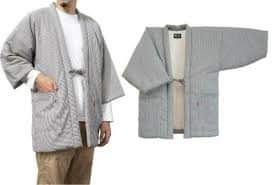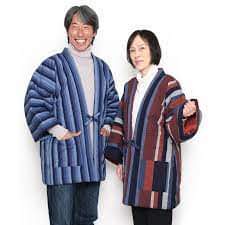Hanten is a Japanese traditional jacket. It had a bamboo collar and the front part of it was made from ramie. Its backside is made from cotton cloth. So it was cool in summer and warm in winter. It was worn by everyone which is a rarity among traditional clothes around the world.
Hanten Is The Japanese Traditional Jacket!
Hanten is worn by both, men and women. It has a bamboo collar and the back is made from cotton cloth. The sleeves are long, but not too long like Kimono sleeves; they’re more like mid-thigh length, which makes it easy to put on without fumbling around when you’re in a hurry or just trying to get dressed quickly before going out!
The Hanten itself comes in many different colors and styles, but what makes it distinctive is its use of materials: most importantly cotton cloth instead of the cotton polyester blend (which would be useless as pants). Also, there’s no lining inside (as opposed to zipped pockets). This means that if you want something waterproofed then you’ll have trouble finding something that fits your needs–even though waterproofing isn’t needed for everyday wear here in Japan where temperatures rarely get above 60 degrees Celsius during summer months!
Japanese Hanten Is Made Of High-Quality Material!
The following is the list of materials used to make Japanese Hanten:
- Cotton Fabric: It is one of the most common materials used to make a Hanten. The fabric has a smooth feel and it can be stretched easily without losing its shape.
- Polyester Fabric: This kind of fabric has an excellent elasticity which makes it more comfortable to wear than cotton fabric. It also has good water absorption properties which makes it suitable for use in humid climates like tropical regions.
- Polyester Jacquard: This type of fabric is extremely durable and resistant to tears, rips, or stains because it has been woven with jacquard technology that makes it very strong and durable compared to other types of fabrics used for making Japanese Hanten such as cotton and polyester blends.
- Rayon: It can be used alone or blended with other types of fabrics such as polyester or cotton to create an amazing Hanten that will last for years without losing its shape or color due to wear and tear caused by frequent usage by people who wear them regularly.

Hanten Had a Bamboo Collar and The Front Part Of It Was Made From Ramie!
Bamboo is a light and durable material. It’s used to make Hanten because it is cool in summer, but warm in winter. Ramie is a plant with fibers that can be woven into cloth, like cotton or wool. The fiber from ramie has been used for centuries to make clothes, tents, and other items that people need for their daily lives.
Ramie is also known as Chinese bamboo (Bambusa vulgaris) or Japanese bamboo (Bambusa multiplex).
Japanese Hanten Backside
Japanese Hanten Was Made from Cotton Cloth. Cotton is a soft, fluffy fiber that comes from the cotton plant. It’s breathable and comfortable to wear as well as versatile in many ways—you can use it for clothing (shirts and pants), towels, bedding, and more.
So, It Was Cool in Summer and Warm in Winter
The Hanten is made from bamboo, ramie, and cotton. It was worn by everyone and not just the rich. It’s a common item of clothing for people in Japan so it’s no surprise that this type of jacket was also used to protect against cold weather in summer and warmth during winter.
Japanese Hanten Was Worn by Everyone!
A Hanten is worn by all Japanese people and around the world which is a rarity among traditional clothes around the world!
Hanten is traditional Japanese garments that were worn by all classes, not just the upper class. They’re usually made of cotton or other natural fibers and can be found in many different colors. Hanten also has a wide variety of styles, depending on where they’re made: some have short sleeves while others cover the entire body; some have long pants while others have short skirts; and so on.
Hanten is cool during summer months because they keep you comfortable while still allowing you to move freely around your home or office. In wintertime, Hanten make it easier for you to stay warm indoors because they trap heat inside them (just like our bodies do!).
The First Step to Making Hanten
The first step to making your customized Hanten is the collar Hanten with popular bamboo thread or with simple wood threads.

The Second Step Is Making a Pattern On The Fabric Of The Cotton Cloth!
The patterns are made by cutting out the fabric, which will be used to make the collar and front part of the Hanten.
The Third Step in Hanten Making!
The third step is sewing the pattern with thread. This is a very important step, and it requires a lot of skill and experience to do well.
Sewing involves using a needle and thread to create holes in fabric that will be sewn together later on (this process is called “hemming”). You can use either hand stitching or machine sewing for this purpose, although we recommend hand stitching whenever possible because it tends to produce cleaner results overall.
The Final Step:
The final step is sewing two parts together by hand. To do this, you’ll start by stitching the front and back of your jacket together along one side seam (with a doubled thread). Then you’ll sew the side seams of both pieces together, including any loose ends that didn’t get sewn in earlier. Finally, you’ll attach sleeves to jackets and adjust fit if needed—just like making any other garment!
There Are 4 Steps to Making a Hanten!
The first step is a collar made with bamboo or wood thread. After that, you can make a pattern on the fabric of cotton cloth. In this case, you need to cut out the pattern and sew it using thread. Finally, it’s time to put all pieces together and finish off any loose ends with glue if necessary!
Materials Used for Hanten in Japan and China
The materials used to make Japanese masks are quite different from those used in China. The main difference between the two is that the material of a Japanese Hanten is made of cotton, while the material of a Chinese Hanten is made of cotton mixed with wool or silk. The reason why there are so many differences between the two is that China and Japan have different climates, so they need different kinds of materials to keep warm. The temperature in Japan during winter can go as low as -30 degrees Celsius (-22 degrees Fahrenheit), while it can get up to 20 degrees Celsius (68 degrees Fahrenheit) in China during summertime. Thus, it’s necessary for people to wear something that can keep them warm when temperatures drop below 0 degrees Celsius (32 degrees Fahrenheit).
As you can see, making a Hanten is not hard at all. The first step is making the collar from bamboo or wood thread. Then, a pattern is drawn on cotton cloth with chalk or grease pencils. And finally, two parts are sewn together by hand.






